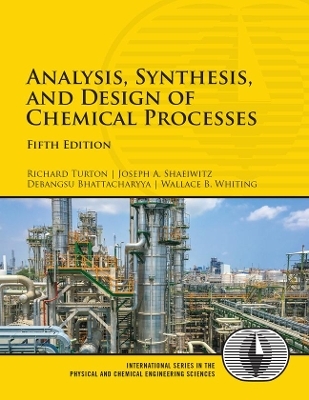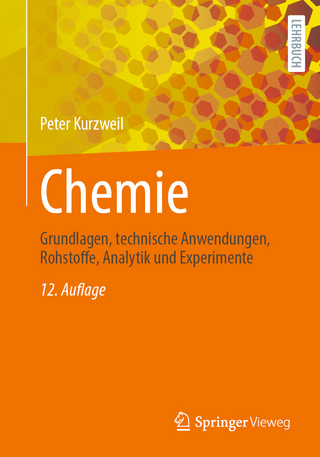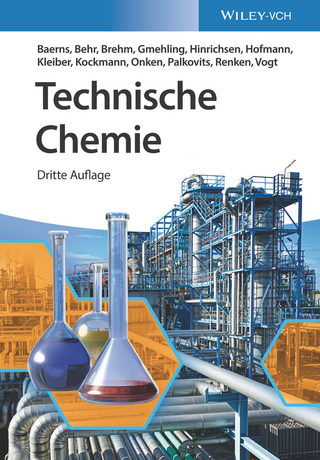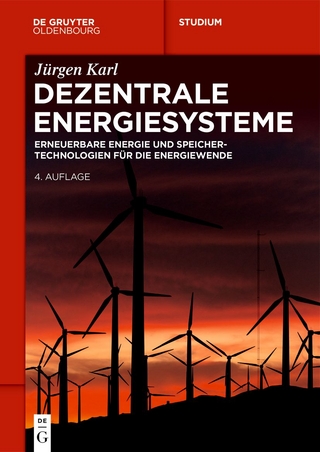
Analysis, Synthesis, and Design of Chemical Processes
Prentice Hall (Verlag)
978-0-13-417740-3 (ISBN)
Conceptualization and analysis: process diagrams, configurations, batch processing, product design, and analyzing existing processes
Economic analysis: estimating fixed capital investment and manufacturing costs, measuring process profitability, and more
Synthesis and optimization: process simulation, thermodynamic models, separation operations, heat integration, steady-state and dynamic process simulators, and process regulation
Chemical equipment design and performance: a full section of expanded and revamped coverage of designing process equipment and evaluating the performance of current equipment
Advanced steady-state simulation: goals, models, solution strategies, and sensitivity and optimization results
Dynamic simulation: goals, development, solution methods, algorithms, and solvers
Societal impacts: ethics, professionalism, health, safety, environmental issues, and green engineering
Interpersonal and communication skills: working in teams, communicating effectively, and writing better reports
This text draws on a combined 55 years of innovative instruction at West Virginia University (WVU) and the University of Nevada, Reno. It includes suggested curricula for one- and two-semester design courses, case studies, projects, equipment cost data, and extensive preliminary design information for jump-starting more detailed analyses.
Richard Turton, P.E., has taught the design and design-related courses at West Virginia University for the past 32 years. Prior to this, he spent five years in the design and construction industry. His main interests are design education and process systems modeling. Joseph A. Shaeiwitz taught design and design-related classes at West Virginia University for more than 25 years. He now teaches design at Auburn University. His interests include design education and outcomes assessment. Debangsu Bhattacharyya has more than ten years' experience in a large petroleum refinery. While in the refinery, he worked in process operations, plant start-up, large-scale process simulation, and process control. His main research interests are in process modeling, dynamic simulation, state estimation, sensor placement, and advanced process control. Wallace B. Whiting, P.E., is professor emeritus at University of Nevada, Reno. He has been involved in the practice and teaching of chemical process design for more than 24 years. Normal 0 false false false EN-US X-NONE X-NONE
Preface xxv
About the Authors xxix
List of Nomenclature xxxi
Chapter 0: Outcomes Assessment 1
0.1 Student Self-Assessment 2
0.2 Assessment by Faculty 4
0.3 Summary 6
References 6
Section I: Conceptualization and Analysis of Chemical Processes 7
Chapter 1: Diagrams for Understanding Chemical Processes 9
1.1 Block Flow Diagram (BFD) 11
1.2 Process Flow Diagram (PFD) 14
1.3 Piping and Instrumentation Diagram (P&ID) 27
1.4 Additional Diagrams 32
1.5 Three-Dimensional Representation of a Process 34
1.6 The 3-D Plant Model 41
1.7 Operator and 3-D Immersive Training Simulators 43
1.8 Summary 48
References 49
Short Answer Questions 49
Problems 50
Chapter 2: The Structure and Synthesis of Process Flow Diagrams 55
2.1 Hierarchy of Process Design 55
2.2 Step 1-Batch versus Continuous Process 56
2.3 Step 2-The Input/Output Structure of the Process 60
2.4 Step 3-The Recycle Structure of the Process 70
2.5 Step 4-General Structure of the Separation System 83
2.6 Step 5-Heat-Exchanger Network or Process Energy Recovery System 83
2.7 Information Required and Sources 83
2.8 Summary 83
References 85
Short Answer Questions 86
Problems 86
Chapter 3: Batch Processing 91
3.1 Design Calculations for Batch Processes 91
3.2 Gantt Charts and Scheduling 97
3.3 Nonoverlapping Operations, Overlapping Operations, and Cycle Times 98
3.4 Flowshop and Jobshop Plants 101
3.5 Product and Intermediate Storage and Parallel Process Units 106
3.6 Design of Equipment for Multiproduct Batch Processes 111
3.7 Summary 113
References 114
Short Answer Questions 114
Problems 114
Chapter 4: Chemical Product Design 123
4.1 Strategies for Chemical Product Design 124
4.2 Needs 125
4.3 Ideas 127
4.4 Selection 128
4.5 Manufacture 130
4.6 Batch Processing 131
4.7 Economic Considerations 131
4.8 Summary 132
References 132
Chapter 5: Tracing Chemicals through the Process Flow Diagram 135
5.1 Guidelines and Tactics for Tracing Chemicals 135
5.2 Tracing Primary Paths Taken by Chemicals in a Chemical Process 136
5.3 Recycle and Bypass Streams 142
5.4 Tracing Nonreacting Chemicals 145
5.5 Limitations 145
5.6 Written Process Description 146
5.7 Summary 147
Problems 147
Chapter 6: Understanding Process Conditions 149
6.1 Conditions of Special Concern for the Operation of Separation and Reactor Systems 150
6.2 Reasons for Operating at Conditions of Special Concern 152
6.3 Conditions of Special Concern for the Operation of Other Equipment 155
6.4 Analysis of Important Process Conditions 158
6.5 Summary 165
References 165
Short Answer Questions 165
Problems 166
Section II: Engineering Economic Analysis of Chemical Processes 169
Chapter 7: Estimation of Capital Costs 171
7.1 Classifications of Capital Cost Estimates 172
7.2 Estimation of Purchased Equipment Costs 175
7.3 Estimating the Total Capital Cost of a Plant 182
7.4 Estimation of Plant Costs Based on Capacity Information 206
7.5 Summary 208
References 208
Short Answer Questions 209
Problems 210
Chapter 8: Estimation of Manufacturing Costs 213
8.1 Factors Affecting the Cost of Manufacturing a Chemical Product 213
8.2 Cost of Operating Labor 218
8.3 Utility Costs 219
8.4 Raw Material Costs 234
8.5 Yearly Costs and Stream Factors 237
8.6 Estimating Utility Costs from the PFD 238
8.7 Cost of Treating Liquid and Solid Waste Streams 240
8.8 Evaluation of Cost of Manufacture for the Production of Benzene via the Hydrodealkylation of Toluene 241
8.9 Summary 242
References 243
Short Answer Questions 243
Problems 244
Chapter 9: Engineering Economic Analysis 247
9.1 Investments and the Time Value of Money 248
9.2 Different Types of Interest 251
9.3 Time Basis for Compound Interest Calculations 254
9.4 Cash Flow Diagrams 255
9.5 Calculations from Cash Flow Diagrams 259
9.6 Inflation 266
9.7 Depreciation of Capital Investment 268
9.8 Taxation, Cash Flow, and Profit 274
9.9 Summary 277
References 277
Short Answer Questions 278
Problems 278
Chapter 10: Profitability Analysis 285
10.1 A Typical Cash Flow Diagram for a New Project 285
10.2 Profitability Criteria for Project Evaluation 287
10.3 Comparing Several Large Projects: Incremental Economic Analysis 295
10.4 Establishing Acceptable Returns from Investments: The Concept of Risk 298
10.5 Evaluation of Equipment Alternatives 299
10.6 Incremental Analysis for Retrofitting Facilities 305
10.7 Evaluation of Risk in Evaluating Profitability 309
10.8 Profit Margin Analysis 325
10.9 Summary 326
References 327
Short Answer Questions 327
Problems 328
Section III: Synthesis and Optimization of Chemical Processes 343
Chapter 11: Utilizing Experience-Based Principles to Confirm the Suitability of a Process Design 347
11.1 The Role of Experience in the Design Process 348
11.2 Presentation of Tables of Technical Heuristics and Guidelines 351
11.3 Summary 354
List of Informational Tables 354
References 368
Problems 368
Chapter 12: Synthesis of the PFD from the Generic BFD 369
12.1 Information Needs and Sources 370
12.2 Reactor Section 372
12.3 Separator Section 373
12.4 Reactor Feed Preparation and Separator Feed Preparation Sections 388
12.5 Recycle Section 389
12.6 Environmental Control Section 389
12.7 Major Process Control Loops 390
12.8 Flow Summary Table 390
12.9 Major Equipment Summary Table 390
12.10 Summary 391
References 391
General Reference 392
Problems 392
Chapter 13: Synthesis of a Process Using a Simulator and Simulator Troubleshooting 397
13.1 The Structure of a Process Simulator 398
13.2 Information Required to Complete a Process Simulation: Input Data 401
13.3 Handling Recycle Streams 413
13.4 Choosing Thermodynamic Models 415
13.5 Case Study: Toluene Hydrodealkylation Process 426
13.6 Electrolyte Systems Modeling 428
13.7 Solids Modeling 440
Appendix 13.1 445
Appendix 13.2 447
13.8 Summary 450
References 451
Short Answer Questions 454
Problems 455
Chapter 14: Process Optimization 463
14.1 Background Information on Optimization 463
14.2 Strategies 469
14.3 Topological Optimization 473
14.4 Parametric Optimization 479
14.5 Lattice Search, Response Surface, and Mathematical Optimization Techniques 489
14.6 Process Flexibility and the Sensitivity of the Optimum 489
14.7 Optimization in Batch Systems 490
14.8 Summary 497
References 498
Short Answer Questions 498
Problems 498
Chapter 15: Pinch Technology 509
15.1 Introduction 509
15.2 Heat Integration and Network Design 510
15.3 Composite Temperature-Enthalpy Diagram 523
15.4 Composite Enthalpy Curves for Systems without a Pinch 524
15.5 Using the Composite Enthalpy Curve to Estimate Heat-Exchanger Surface Area 525
15.6 Effectiveness Factor (F) and the Number of Shells 529
15.7 Combining Costs to Give the EAOC for the Network 534
15.8 Other Considerations 536
15.9 Heat-Exchanger Network Synthesis Analysis and Design (HENSAD) Program 540
15.10 Mass-Exchange Networks 541
15.11 Summary 550
References 550
Short Answer Questions 551
Problems 552
Chapter 16: Advanced Topics Using Steady-State Simulators 561
16.1 Why the Need for Advanced Topics in Steady-State Simulation? 562
16.2 User-Added Models 562
16.3 Solution Strategy for Steady-State Simulations 571
16.4 Studies with the Steady-State Simulation 589
16.5 Estimation of Physical Property Parameters 601
16.6 Summary 605
References 605
Short Answer Questions 607
Problems 607
Chapter 17: Using Dynamic Simulators in Process Design 617
17.1 Why Is There a Need for Dynamic Simulation? 618
17.2 Setting Up a Dynamic Simulation 619
17.3 Dynamic Simulation Solution Methods 633
17.4 Process Control 639
17.5 Summary 647
References 647
Short Answer Questions 648
Problems 649
Chapter 18: Regulation and Control of Chemical Processes with Applications Using Commercial Software 655
18.1 A Simple Regulation Problem 656
18.2 The Characteristics of Regulating Valves 657
18.3 Regulating Flowrates and Pressures 660
18.4 The Measurement of Process Variables 662
18.5 Common Control Strategies Used in Chemical Processes 663
18.6 Exchanging Heat and Work between Process and Utility Streams 674
18.7 Logic Control 680
18.8 Advanced Process Control 682
18.9 Case Studies 683
18.10 Putting It All Together: The Operator Training Simulator (OTS) 688
18.11 Summary 689
References 690
Problems 690
Section IV: Chemical Equipment Design and Performance Process Equipment Design and Performance 695
Chapter 19: Process Fluid Mechanics 697
19.1 Basic Relationships in Fluid Mechanics 697
19.2 Fluid Flow Equipment 703
19.3 Frictional Pipe Flow 709
19.4 Other Flow Situations 723
19.5 Performance of Fluid Flow Equipment 736
References 755
Short Answer Questions 756
Problems 757
Chapter 20: Process Heat Transfer 771
20.1 Basic Heat-Exchanger Relationships 771
20.2 Heat-Exchange Equipment Design and Characteristics 779
20.3 LMTD Correction Factor for Multiple Shell and Tube Passes 789
20.4 Overall Heat Transfer Coefficients-Resistances in Series 798
20.5 Estimation of Individual Heat Transfer Coefficients and Fouling Resistances 800
20.6 Extended Surfaces 828
20.7 Algorithm and Worked Examples for the Design of Heat Exchangers 837
20.8 Performance Problems 846
References 859
Appendix 20.A Heat-Exchanger Effectiveness Charts 861
Appendix 20.B Derivation of Fin Effectiveness for a Rectangular Fin 864
Short Answer Questions 866
Problems 866
Chapter 21: Separation Equipment 875
21.1 Basic Relationships in Separations 876
21.2 Illustrative Diagrams 883
21.3 Equipment 911
21.4 Extraction Equipment 942
21.5 Gas Permeation Membrane Separations 947
References 951
Short Answer Questions 952
Problems 954
Chapter 22: Reactors 961
22.1 Basic Relationships 962
22.2 Equipment Design for Nonisothermal Conditions 980
22.3 Performance Problems 1003
Chapter 23: Other Equipment 1015
23.1 Pressure Vessels 1016
23.2 Knockout Drums or Simple Phase Separators 1024
23.3 Steam Ejectors 1049
References 1058
Short Answer Questions 1059
Problems 1060
Chapter 24: Process Troubleshooting and Debottlenecking 1065
24.1 Recommended Methodology 1067
24.2 Troubleshooting Individual Units 1071
24.3 Troubleshooting Multiple Units 1076
24.4 A Process Troubleshooting Problem 1081
24.5 Debottlenecking Problems 1085
24.6 Summary 1091
References 1091
Problems 1091
Section V: The Impact of Chemical Engineering Design on Society 1101
Chapter 25: Ethics and Professionalism 1103
25.1 Ethics 1104
25.2 Professional Registration 1121
25.3 Legal Liability [13] 1125
25.4 Business Codes of Conduct [14, 15] 1126
25.5 Summary 1127
References 1128
Problems 1129
Chapter 26: Health, Safety, and the Environment 1131
26.1 Risk Assessment 1131
26.2 Regulations and Agencies 1134
26.3 Fires and Explosions 1143
26.4 Process Hazard Analysis 1145
26.5 Chemical Safety and Hazard Investigation Board 1153
26.6 Inherently Safe Design 1153
26.7 Summary 1154
26.8 Glossary 1154
References 1156
Problems 1157
Chapter 27: Green Engineering 1159
27.1 Environmental Regulations 1159
27.2 Environmental Fate of Chemicals 1160
27.3 Green Chemistry 1163
27.4 Pollution Prevention during Process Design 1164
27.5 Analysis of a PFD for Pollution Performance and Environmental Performance 1166
27.6 An Example of the Economics of Pollution Prevention 1167
27.7 Life Cycle Analysis 1168
27.8 Summary 1169
Section VI: Interpersonal and Communication Skills 1173
Chapter 28: Teamwork 1175
28.1 Groups 1175
28.2 Group Evolution 1184
28.3 Teams and Teamwork 1186
28.4 Misconceptions 1189
28.5 Learning in Teams 1189
28.6 Other Reading 1190
28.7 Summary 1191
References 1192
Problems 1192
Chapter 29: Written and Oral Communication 1195
29.1 Audience Analysis 1196
29.2 Written Communication 1196
29.3 Oral Communication 1209
29.4 Software and Author Responsibility 1215
29.5 Summary 1218
References 1218
Problems 1219
Chapter 30: A Report-Writing Case Study 1221
30.1 The Assignment Memorandum 1221
30.2 Response Memorandum 1222
30.3 Visual Aids 1224
30.4 Example Reports 1230
30.5 Checklist of Common Mistakes and Errors 1244
Appendix A: Cost Equations and Curves for the CAPCOST Program 1247
A.1 Purchased Equipment Costs 1247
A.2 Pressure Factors 1264
A.3 Material Factors and Bare Module Factors 1267
References 1275
Appendix B: Information for the Preliminary Design of Fifteen Chemical Processes 1277
B.1 Dimethyl Ether (DME) Production, Unit 200 1278
B.2 Ethylbenzene Production, Unit 300 1283
B.3 Styrene Production, Unit 400 1291
B.4 Drying Oil Production, Unit 500 1299
B.5 Production of Maleic Anhydride from Benzene, Unit 600 1305
B.6 Ethylene Oxide Production, Unit 700 1311
B.7 Formalin Production, Unit 800 1317
B.8 Batch Production of L-Phenylalanine and L-Aspartic Acid, Unit 900 1323
B.9 Acrylic Acid Production via the Catalytic Partial Oxidation of Propylene [1-5], Unit 1000 1329
B.10 Production of Acetone via the Dehydrogenation of Isopropyl Alcohol (IPA) [1-4], Unit 1100 1338
B.11 Production of Heptenes from Propylene and Butenes [1], Unit 1200 1344
B.12 Design of a Shift Reactor Unit to Convert CO to CO2, Unit 1300 1352
B.13 Design of a Dual-Stage Selexol Unit to Remove CO2 and H2S From
B.14 Design of a Claus Unit for the Conversion of H2S to Elemental Sulfur, Unit 1500 1363
B.15 Modeling a Downward-Flow, Oxygen-Blown, Entrained-Flow Gasifier, Unit 1600 1371
Appendix C: Design Projects 1379
Project 1 Increasing the Production of 3-Chloro-1-Propene (Allyl Chloride) in Unit 600 1381
Project 2 Design and Optimization of a New 20,000-Metric-Tons-per-Year Facility to Produce Allyl Chloride at La Nueva Cantina, Mexico 1394
Project 4 The Design of a New 100,000-Metric-Tons-per-Year Phthalic Anhydride Production Facility 1412
Project 5 Problems at the Cumene Production Facility, Unit 800 1417
Project 6 Design of a New, 100,000-Metric-Tons-per-Year Cumene Production Facility 1430
Index 1433
| Erscheinungsdatum | 05.09.2018 |
|---|---|
| Reihe/Serie | International Series in the Physical and Chemical Engineering Sciences |
| Verlagsort | Upper Saddle River |
| Sprache | englisch |
| Maße | 100 x 100 mm |
| Gewicht | 100 g |
| Themenwelt | Naturwissenschaften ► Chemie ► Technische Chemie |
| Technik ► Umwelttechnik / Biotechnologie | |
| ISBN-10 | 0-13-417740-1 / 0134177401 |
| ISBN-13 | 978-0-13-417740-3 / 9780134177403 |
| Zustand | Neuware |
| Haben Sie eine Frage zum Produkt? |
aus dem Bereich


